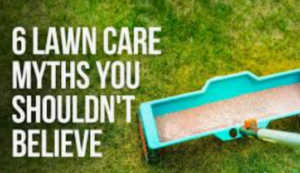
Let’s dispel some of the common myths about lawn care so you can get your yard off to the best start this season:
- Myth #1: The best time to replant the lawn is in the spring when plants are getting ready to bloom.
Reality: Sowing seeds in the spring sets up potential problems. Early-season weeds will compete for the space – and hot and stressful months that are hard on developing grass are still ahead. Sow seed in the fall when the temperatures are more moderate and competing weeds have gone dormant.
- Myth #2: To have a healthy lawn, you need to de-thatch in the spring.
Reality: Thatch is a layer of living and dead plant material, including the crown, roots and stems of turf grass. The brown on the surface at the beginning of the spring will slowly recede into the background as new leaves emerge. A better practice for most lawns is to aerate–this practice opens up spaces in the root zone where oxygen, water and nutrients can head directly to the roots.
- Myth #3: It’s a good idea to remove clippings after mowing.
Reality: There is a misconception that grass clippings contribute significantly to thatch. Grass clippings are mostly water and decompose rapidly, returning significant amounts of fertilizer to the lawn. Research shows that up to one-third of applied fertilizer can be recycled by simply leaving the clippings on top of the lawn. Using a mulching mower to do this is a smart, sustainable practice.
- Myth #4: Golf courses cut their grass short, so it’s a good idea to do the same.
Reality: Golf courses need to maintain turf in ways that benefit the game of golf, and they use incredibly sophisticated and expensive mowers to achieve a shortcut. Cutting to a height of about three inches allows the lawn to shade itself, which helps keep it cool and retain more moisture. Try to avoid cutting off more than a third of the grass at a time.
- Myth #5: Lawns are not “organic.”
Reality: Lawns are highly complex and dynamic organic systems that not only contain turf grass plants but also earthworms, fungi, soil microbes, and other life forms that contribute to the urban ecosystem. They also cool the environment.
- Myth #6: The products lawn care companies use are dangerous and more powerful than what a homeowner can use.
Reality: Many of the products professionals use can be purchased by homeowners at the local garden center. The difference is that professionals are trained and regulated. By law, they have to use the proper amounts of products, apply them correctly, and dispose of containers and other materials properly. They won’t be tempted to “add just a little more to get the job done.” They know better. However, licensed lawn care professional can use more powerful products, just like specialist doctors and prescribe more powerful medications that internal medicine or general practitioners.
Click “DO IT FOR ME” to request a FREE quote.

Source: customer-service@bestyard.com in collaboration with Associated Landscape Contractors of Colorado

























